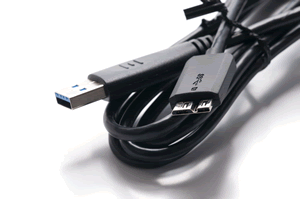Which Materials Enhance USB Performance?
High-performance polyamides provide improved reliability and safety in next-generation USB-C connectors.
 USB-C connectors will need to carry more power than previous generations in a much smaller form factor, which makes the performance properties of the materials used for holding all the conductive elements together especially critical. Reliability is a key requirement, so the industry is looking for plastics that are tough, reliable, rigid, and provide high flow. Plastics processors are gearing up for production, with many now going through approval stages with prototypes and early samples. Total production levels are probably no more than around one million pieces per month, but when production is in full swing, volumes will be 10 times that.
USB-C connectors will need to carry more power than previous generations in a much smaller form factor, which makes the performance properties of the materials used for holding all the conductive elements together especially critical. Reliability is a key requirement, so the industry is looking for plastics that are tough, reliable, rigid, and provide high flow. Plastics processors are gearing up for production, with many now going through approval stages with prototypes and early samples. Total production levels are probably no more than around one million pieces per month, but when production is in full swing, volumes will be 10 times that.
The Type-C connector supports the new SuperSpeed USB 3.1 format, which offers data-transfer rates as high as 10Gb/s or roughly double the speed of current USB 3.0 versions. It’s still backward-compatible with all the USB 2.0 formats (LS, FS, and HS), so even legacy systems will be able to take advantage of the new connector when it’s designed into dongles.
The introduction of the USB-C connector is also an answer to the call to reduce electronic waste. Legislators in Europe, for example, have for several years been pushing the use of a standardized charging interface, so that one charger and its associated cable can be used for multiple devices; similar moves have taken place in China and Korea.
As a result, the USB-C connector will become the standard design from 2017 on, as decreed by USB Implementers Forum (USB IF), the non-profit corporation founded by the group of companies that developed the original Universal Serial Bus specification.
The USB Power Delivery specification is also being updated to enable USB PD to support the USB-C Cable and Connector specification, for charging up to 100W. USB-C specifications are contained within the overall USB 3.1 standard that also covers data transmission rates.
New Design = New Materials Challenge
The USB-C connector represents a major challenge in terms of design and production. That is because the USB-C connector is much smaller than its predecessors, and yet it has to handle much more power. The various pins on the USB-C connector are spaced with a pitch of just 0.5mm, compared with 0.65mm on a USB 3.0 Micro B connector and 2.0mm on a USB Type A connector. The thinnest insulating wall has been reduced from 1.84mm on the USB Type A to a miniscule 0.12mm on a USB-C connector. It is difficult to successfully design and consistently mold parts with such thin walls and maintain the necessary mechanical and electrical properties.
Tough Material Performance Requirements
As already noted, USB-C connectors will need to carry more power than previous generations in a much smaller form factor, so the performance properties of the materials used for holding all the conductive elements together are especially critical. Reliability is a key requirement, so the industry is looking for plastics that are tough, reliable, rigid, and which provide high flow.
Many component producers have begun developments in new USB-C connector designs using liquid crystal polymers (LCPs). Traditionally, LCPs are often favored in thin-wall electronics because of their excellent flow properties and because prices of some commodity grades are relatively low, sometimes under $10/kg; LCPs are well-known by USB connector makers, since they have been the favored polymer in previous generations of USB.
But in many cases, USB-C connectors are likely to fail stringent tests regarding their electrical properties, especially resistance to surface tracking, expressed as the Comparative Tracking Index (CTI), and also mechanical properties.
The Importance of CTI
The CTI of the plastic that acts as an insulator as well as a mechanical anchor around the conductors is more than ever a key for product reliability with the USB-C connector. If the insulator does not have sufficiently high CTI, there is a risk that at some point a short circuit will result, damaging the device and possibly even starting a fire. This is not fearmongering – there are various reports of mobile devices catching fire during charging.
There are essentially three routes to reduce risk of fire hazard caused by tracking:
- Increasing the creeping distance (defined by conductor pitch and insulator wall thickness)
- Lowering the level of environmental pollution (dust, sweat, etc.)
- Using an insulation material with a higher CTI
The creeping distance in the connectors is pre-defined and cannot be modified. Reduction of the level of environmental pollution at connector level can only be done by additional sealing, which adds to the cost of the device, so using a material for the insulator with as high a CTI as possible is the most viable solution to increase end-product safety.
Potential Real-Life Failure Mode
Solutions more appropriate than those possible with LCPs or halogen-containing PAs (PA9T or PA6T) can be found with high-performance halogen-free polyamides, such as PA46 and PA4T.
High-performance polyamides 46 and 4T offer the best balance of mechanical and electrical properties and precision molding. Polyamides 46 and 4T already have been approved by several global producers for use in the next generation of USB-C connectors. They answer the need for improved levels of safety and reliability. PA46 and PA4T both have high CTIs of PLC class 0, well above the recommended 400V. They maintain this high performance for twice as long as alternative materials such as LCPs, most of which have CTIs under 400V.
In tests on connectors produced in LCP, the connector pins fail after nine drops, causing a short circuit; neither PA46 nor PA4T fails at all. It is, therefore, not surprising that halogen-free polyamides are explicitly recommended by the USB-IF in the USB 3.1 specification. Mechanical requirements placed on thermoplastics used in USB-C connector plugs and receptacles are considerable. Fine details in the physical structures of USB-C connector plug housings vary among producers, but in all cases, from a mechanical point of view, the biggest challenge is the balance between toughness and stiffness. High-performance polyamides from DSM offer an ideal balance in this regard. Furthermore, the flame-retardant additive systems that they incorporate to provide a UL 94 V-0 rating contain no halogens.
One of the most critical parts of the connector plug housing is the ribs that separate the metal contacts for power and data transfer. As indicated earlier, these ribs are normally little more than 0.12mm in thickness, putting extraordinary demands on the processing properties of plastics materials. PA46 and PA4T both offer high flow in combination with high weld-line strength. This ensures excellent processing, which is needed to meet demands for very high levels of productivity, and it also provides connector designers with flexibility in component structure and tooling design. On the other hand, the required high pin pull-out strength (the force needed to pull metal contacts out of the housing) is ensured.
USB-C connectors may be very small, but they are complicated assemblies of plastics and metal. Different producers are considering slightly different routes in the design, but one favored route, at least for the receptacle, is to use a process that involves sequential insert molding. A sort of “preform” is first made, which has a set of contacts embedded in it, and then this is used in a second insert molding process in which additional metal components are incorporated into the assembly.
With two-stage insert molding, it is advisable to use a thermoplastic in the first stage that has a melting point higher than that used in the second stage, to ensure that no re-melting occurs that could cause the first set of inserts to shift position. But this second material still needs to have a melting point high enough to resist the temperatures involved in any possible subsequent high-temperature soldering process.
An ideal solution, therefore, is to use PA4T for the first insert molding stage; this has a melting point of 325°C. The second insert molding stage can then be done with PA46, which has a melting point of 295°C.
The most difficult part of a USB-C connector to produce is the plug front housing. Very thin ribs require high flow and tough material, and there is a weld line on the front side, which mandates a material with high welding-line strength.
Material requirements listed below can all be fulfilled by high-performance polyamides PA46 and PA4T:
- High flow for 0.12mm wall thickness design
- High levels of stiffness, toughness, and welding line strength
- High-wear friction strength and high retention force (10,000 times mating/unmating durability test)
- Good process window
- UL 94-V0 and high CTI (400V) to support USB PD 1.0 and 2.0 standards (up to 5A and 20V)
- Good colorability to support consumer electronics market needs
- Lead-free reflow soldering
- Compatible with high-speed signal transfer up to 10Gb/s
To read this white paper in its entirety, click here.
This article was contributed by DSM.




